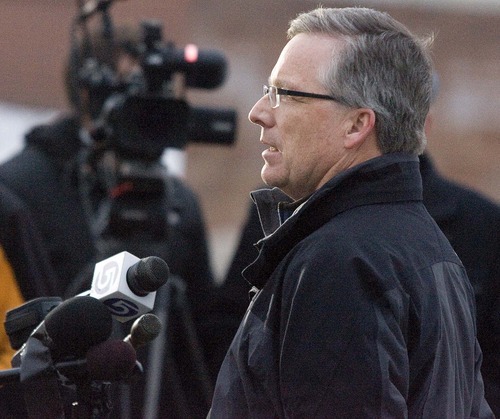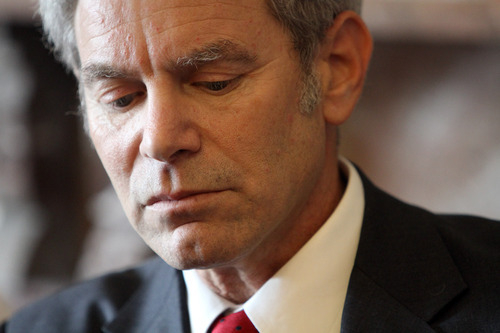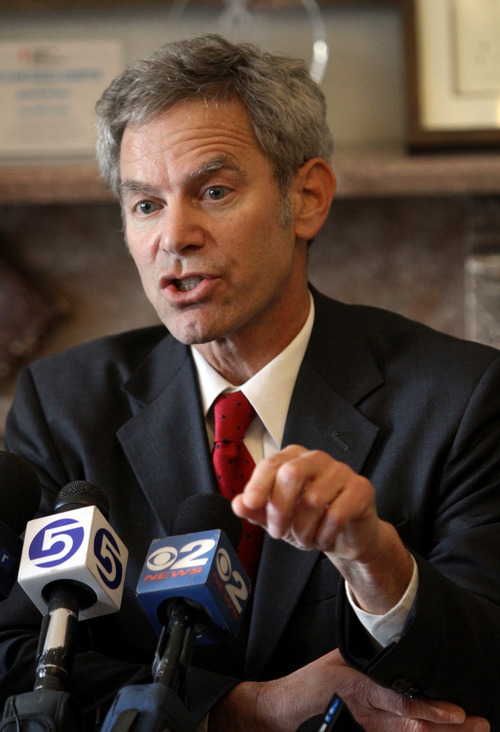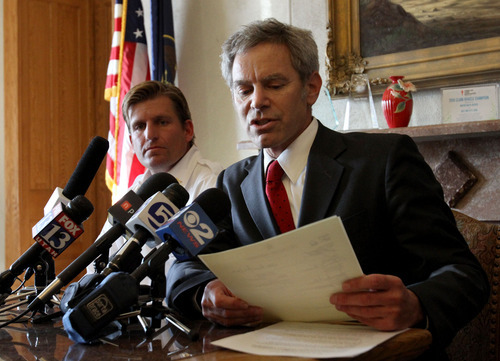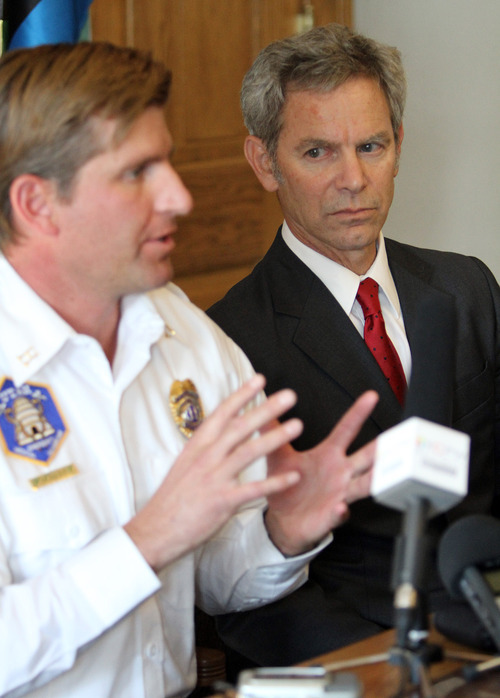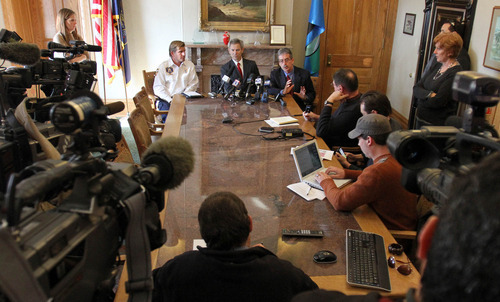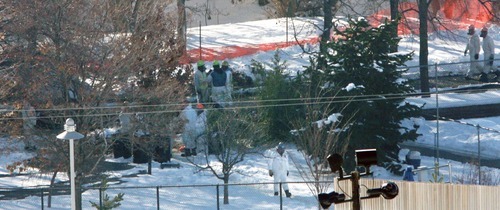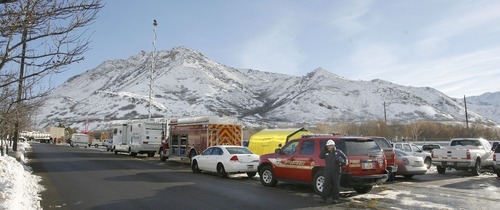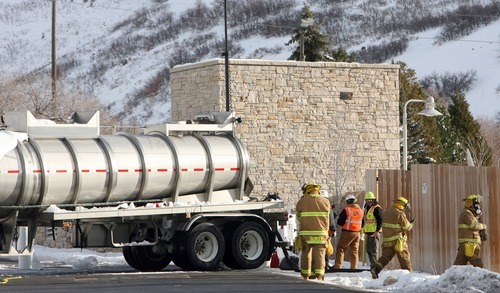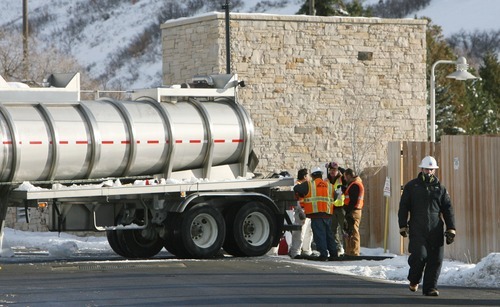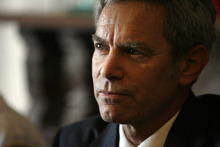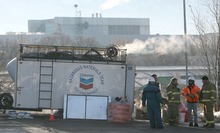This is an archived article that was published on sltrib.com in 2010, and information in the article may be outdated. It is provided only for personal research purposes and may not be reprinted.
Chevron's second oil leak in six months near Red Butte Garden brought Salt Lake City perilously close — 50 feet close — to another environmental disaster late Wednesday.
That's far too alarming for Salt Lake City residents and City Hall officials. They want the pipeline shut down.
For Mayor Ralph Becker, you could call it a crude awakening. At first light Thursday, Becker was traipsing through the snow west of Red Butte Creek to survey the damage.
"Outraged," the mayor later that morning demanded Chevron shut down the 60-year-old pipeline that also spilled 800 barrels of crude oil into the stream in June.
"At this point we cannot trust Chevron," Becker said at a news conference called in the wake of Wednesday night's 100- to 200-barrel leak. "Chevron ... has broken the trust we have and the work that's been done to give us a safe pipeline and [our efforts] to protect the community."

The company's control crew in Houston initially detected a pipeline "anomaly" at 8:30 p.m. Wednesday. But it took nearly three hours before Chevron could get a team together, pinpoint the source and notify the city, according to Salt Lake City refinery manager Mark Sullivan said.
Crews discovered oil overflowing from a concrete vault housing pipeline valves near the entrance to Red Butte Garden, about100 yards from the site of the June 11-12 rupture that crews have been cleaning up ever since.
Chevron reported the leak to the Salt Lake City Fire Department at 11:23 p.m.
Hazardous-materials workers and firefighters, assisted by Chevron workers, hemmed in the spill with earthen berms. Crews also deployed oil-absorbing booms in nearby Red Butte Creek. The overnight flow, slowed by freezing temperatures, was contained 90 minutes later and stopped 50 feet short of the stream. Chevron, state and city officials said none of the oil reached the waterway.
Chevron closed the pipeline at a shut-off valve at Little Mountain up Emigration Canyon.
"Seven vacuum trucks are at the scene collecting the material from earthen berms constructed at the scene to contain the material," said Chevron Pipe Line Co. spokesman Mickey Driver. "There has been no water impacted at this time."
The June leak poured oil into the creek, Liberty Park's pond and a stretch of the Jordan River. Chevron received permission eight days after that spill — blamed on an electrical arc that led to a puncturing of the pipe — to put the line back in service. The U.S. Transportation Department's pipeline safety officemade the allowance after the oil giant tested a 14-mile section of the line at five times its normal operating pressure.
Last month, federal regulators proposed a $423,600 fine against Chevron Pipe Line Co. for the June spill. Federal officials confirmed that the oil giant said Thursday it would not contest the fine — due within 20 days of issuance. Sullivan said Chevron paid it Thursday.
At a Thursday evening news conference near the spill site, where the pungent odor of petroleum filled the air, Sullivan insisted there was an important difference between this leak and the June spill, which he called "a completely random event." This spill's environmental impact was quickly limited, he said.
Sullivan deflected questions about the need for an escrow fund to cover spill impacts, emphasizing that Chevron facilities have a long history of operating safely and without environmental harm. But he said the company would "absolutely support" an independent investigation.
However, such a probe cannot begin until the hazardous and potentially explosive fumes clear. "The leak site is currently unsafe for our investigators," Sullivan said.
Though he said the pipeline would not go back online until the company and regulators are confident it can operate safely again, Sullivan indicated he is confident that day will come.
"It's our privilege to operate our facilities in the community," he said. "We know that it's our responsibility to operate those safely and in an environmentally sound manner, and it is the expectation of all of us that we operate each of our facilities that way every day."
But Becker said this latest pipeline failure was the last straw. He has written the Pipeline and Hazardous Materials Safety Administration (PHMSA) and demanded it close the pipeline indefinitely while it conducts an independent analysis of the latest incident.
One PHMSA investigator was at a site nearby and arrived Thursday morning. A second investigator arrived in Salt Lake City in the afternoon.
"Our review of the internal pipeline inspections in June revealed no integrity issues with the pipe," PHMSA spokeswoman Julia Valentine wrote in an e-mail. "There was no history of past valve failures on this line segment and no observed valve deficiencies during our field inspections. However, PHMSA is investigating the cause of the valve failures to see if they pose a systemic problem that Chevron must address."
The agency said it inspected the valve linked to Wednesday's leak. "This line was pressure-tested prior to the June restart," Valentine wrote, "and no leaks were detected during PHMSA's inspection."
Asked whether it was a mistake to restart the pipeline in June, the PHMSA e-mail doesn't directly say. Instead, it recounts the cause of the earlier spill and the steps Chevron would have to take. As to whether the fine was sufficient, Valentine said it "was specific to the safety violations identified by PHMSA in our investigation into the June release."
Becker said the city does not have the authority to shut down the pipeline. In addition to requesting the feds take action, the mayor said he has enlisted members of Utah's congressional delegation, Gov. Gary Herbert and Salt Lake County Mayor Peter Corroon in his campaign to hold Chevron accountable.
"I know that I have their full backing that this pipeline needs to be curtailed in its use," Becker said, "until we have every assurance that our community is protected."
Others echoed the mayor's anger and his call for the pipeline's closure.
"This outrageous spill demonstrates Chevron's incompetence in distributing oil through our community" said Zach Frankel, executive director of the Utah Rivers Council. "There should be an immediate halt to the distribution of any and all oil through this pipeline until a comprehensive study can be completed and distributed to the public which proves no more spills will occur. Chevron is being a bad corporate steward of Utah's environment."
U.S. Rep. Jim Matheson, D-Utah, applauded city emergency crews for protecting the creek but called the second leak "a concern."
"I will be in close communication with pipeline safety officials," said the Utah Democrat, whose district includes the spill area, "to make sure that permanent solutions are found and implemented."
Herbert said he supports "the city's and county's efforts to keep the pipeline shut down until all safety concerns have been resolved."
Walt Baker, director of the Utah Division of Water Quality, agreed no oil apparently reached Red Butte Creek. But state crews were taking water samples to ensure that.
Jeff Niermeyer, the city's director of public utilities, said an air-quality crew was on site "from the start" to monitor conditions. He discounted any notion of sabotage to the pipeline, noting Chevron employees saw no footprints around the vault.
Salt Lake City Fire Capt. Michael Harp said low temperatures helped thicken the oil and slow its flow. "Most of the product remained inside the vault," he said.
Still, a substantial amount of crude overflowed into the parking area near the entrance of Red Butte Garden and was approaching the creek before crews got the upper hand.
"It was contained," Harp said. "None of the oil made it to the creek as far as we can tell."
Baker said the oil, congealed in globs, did contaminate some soil.
"It's disappointing and unacceptable," Baker said of the latest spill.
A University of Utah spokesman said no students in nearby dorms have asked for new housing arrangements due to the odor, but said accommodations could be made if necessary.
Red Butte Garden itself was spared, according to Executive Director Gregory Lee, though greenhouse workers in the lower gardens were dismissed Thursday as a safety precaution.
"If this had happened in the middle of the concert season — like before the Willie Nelson show — oh man, it would be a different story," Lee said. "But this should have minimal effect on the garden."
City Councilwoman Jill Remington Love praised the mayor for demanding to keep the pipeline closed.
"I can't imagine, for the folks who live along Red Butte Creek, how frustrating this must be," she said. "It was really the odor that bothered a lot of people. This is a frustrating day."
Indeed, the June leak still plagues the neighborhood, according to George Kelner, chairman of the Yalecrest Community Council.
"There's still a considerable amount of lingering anger," he said. "There's a feeling that the creek will never be the same — that people's property will be irreparably damaged. This is just going to add to that. There's not huge trust in Chevron."
At the same time, City Council Chairman J.T. Martin called for a measured response, arguing the pipeline is crucial to the state's economy. "I do not think it's practical to talk about shutting them down," Martin said. "They're a pretty vital lifeline for our refineries. Oil and gas prices could go way up. We've got to think past our nose on this one."
Still, Martin would like to see Chevron deploy an around-the-clock response team — complete with helicopter checks of its pipelines — until the federal government gives the pipeline a clean bill of health.
Peter Hayes, whose Yalecrest backyard still reeks from June's spill, said the response by government and the company fell far short.
"These people, they don't get it," he said. "I'm angry at the government for not speaking up for the people they are supposed to protect. I'm angry at Chevron for ignoring the safety and the welfare for the people they serve."
Asked if the city was too accommodating to Chevron during the summer cleanup, Becker bristled. "We never relied on Chevron for their response," the mayor said. "We had independent experts for the spill."
Still, the mayor conceded, "we don't have the expertise in-house to provide the assurance that this pipeline is going to be safe."
Chevron had planned to announce a $10,000 donation to the Utah Food Bank on Thursday morning but postponed the event. The time was set for 10 a.m., the same time Becker addressed reporters about the latest spill.
djensen@sltrib.com
fahys@sltrib.com —
How dangerous is latest Chevron oil spill?
Based on initial air-quality monitoring at the spill site from Industrial Hygiene Inc. (IHI) Environmental, the independent consultants contracted by Salt Lake City since the first spill, low vapor levels have been detected.
Sensitive individuals who are experiencing discomfort or symptoms should seek medical help or call the Salt Lake Valley Health Department with questions or concerns at 801-534-4600. The Utah Division of Water Quality — a branch of the state's Department of Environmental Quality — is taking water samples for further evaluation. Test results and other spill-related information will be posted at www.slcgov.com/oilspill as soon as it is available.
An incident hot line was set up at 866-752-6340. Residents can also call 801-535-7171 with questions or concerns.
The city ombudswoman for the oil spill, Robin Carbaugh, has been in contact with some residents affected by the previous spill and is available to hear concerns at801-870-1428, or ombudslc@gmail.com.


